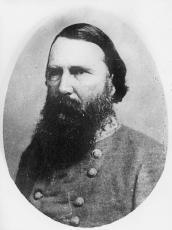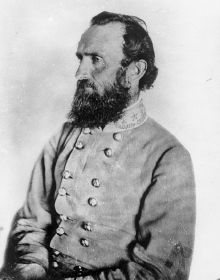Authors: David J. Eicher
Dixie Betrayed (55 page)

A North Carolina professor of mathematics, D. H. Hill was a bitter, combative, and aggressive general officer. He fought in one of the first land battles of the war at Big Bethel and went on to the Virginia peninsula, Antietam, and Chickamauga. He criticized his superiors and got entangled in a grave dispute with Braxton Bragg over a petition requesting removal of Bragg from army command. Davis supported his friend Bragg, and Hill’s career was ruined. He spent the rest of the war trying to clear his name.
Library of Congress

Robert E. Lee’s senior corps commander and most trusted lieutenant was Georgia-born James Longstreet. This corps commander led his troops well throughout the war, though he has been blamed by hard-core Virginians for the loss at Gettysburg and everything else that ailed the Confederate cause.
Library of Congress

Thomas J. Jackson, known as “Stonewall” ever since First Manassas, was the South’s great hero general of the first half of the war. A Virginian and friend of Robert E. Lee’s, Stonewall set a spirit of aggressiveness the South felt it needed for victory. His mortal wounding at Chancellorsville and subsequent death stunned the South and coincided with a strategic back-slide that saw Union victories at Gettysburg and Vicksburg.
National Archives and Records Administration

As a young Virginia cavalry officer, James E. B. ( Jeb) Stuart epitomized the hope of Confederate civilians. He served gallantly and rose to major general over the course of First Manassas, the Peninsular campaign, Chancellorsville, and Gettysburg. At Yellow Tavern outside Richmond in May 1864, however, Stuart was mortally wounded, and he died the next day in Richmond.
Library of Congress

Hollywood Cemetery, begun in 1847, stands west of the city on high ground overlooking the James River. It served as the principal burying ground for Confederate soldiers returned to Richmond, including Jeb Stuart, in early 1864. Stuart’s first gravestone stands starkly in an 1865 image.
Library of Congress

The Tredegar Iron Works, the most significant iron factory in the South, was chartered in 1837. The factory operated throughout the war, supplying much of the armament of the Confederacy, under Brig. Gen. Joseph R. Anderson, the firm’s president. The canal bridge in this April 1865 image leads to Brown’s Island, site of Confederate ordnance experiments.
Library of Congress

Located on the James River along the eastern quarter of the city, Rocketts Landing served as the city’s wharf and docks. This view, taken in April 1865, shows the Confederate Navy Yard on the opposite shore and Union naval vessels anchored downstream. Lincoln docked here on his journey into the fallen city.
Library of Congress

In 1862 Confederate officials commandeered a variety of warehouses to serve as prisons, housing the swell of Yankees captured during the Peninsular campaign. The most famous was Libby Prison, which contained Union officers. A notable escape occurred here in 1864, before the warehouse was torn down brick by brick and — in 1892 — rebuilt at the Chicago World’s Fair.
Cook Collection, Valentine Museum

Rubble in the burnt district in Richmond, photographed in April 1865, testifies to the wanton destruction within the capital as the end of the war came.
Library of Congress
